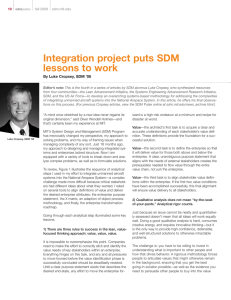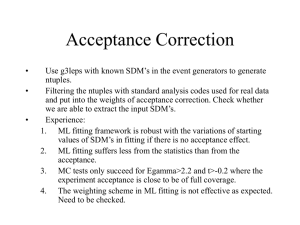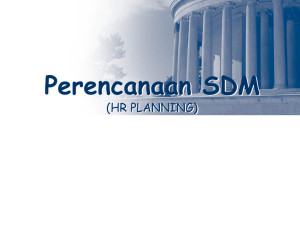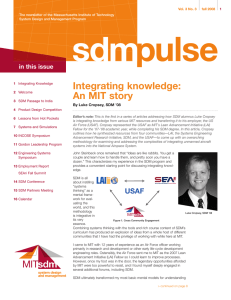Analysis of Hybrid Distance Learning: Corporate Employees in Academic Courses
advertisement
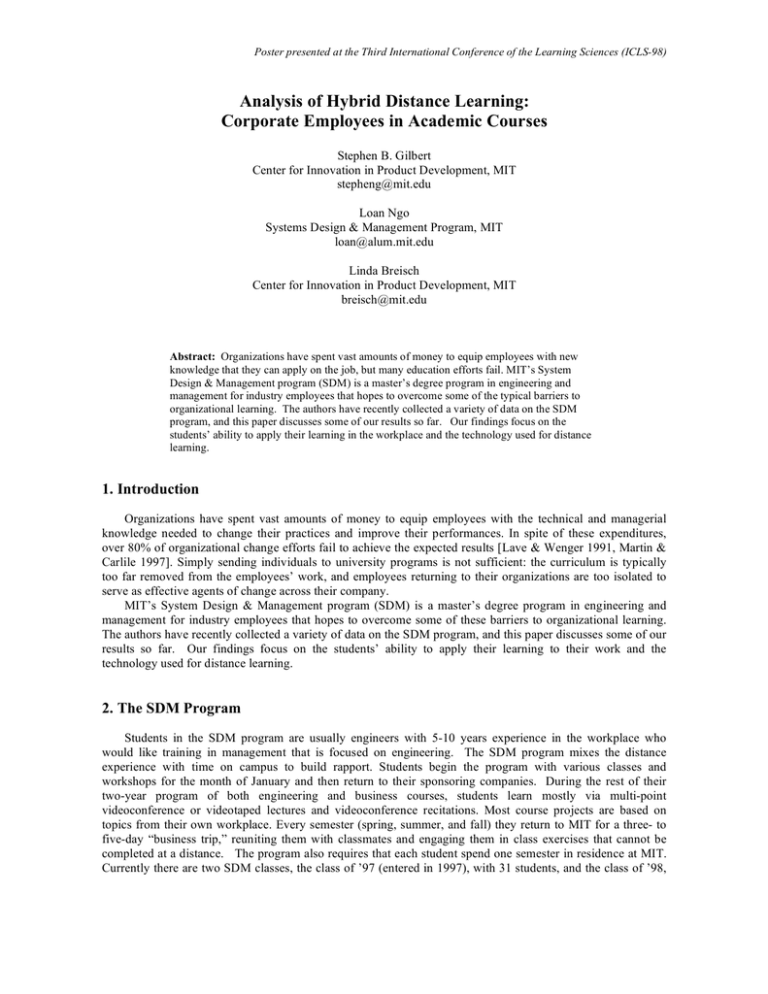
Poster presented at the Third International Conference of the Learning Sciences (ICLS-98) Analysis of Hybrid Distance Learning: Corporate Employees in Academic Courses Stephen B. Gilbert Center for Innovation in Product Development, MIT stepheng@mit.edu Loan Ngo Systems Design & Management Program, MIT loan@alum.mit.edu Linda Breisch Center for Innovation in Product Development, MIT breisch@mit.edu Abstract: Organizations have spent vast amounts of money to equip employees with new knowledge that they can apply on the job, but many education efforts fail. MIT’s System Design & Management program (SDM) is a master’s degree program in engineering and management for industry employees that hopes to overcome some of the typical barriers to organizational learning. The authors have recently collected a variety of data on the SDM program, and this paper discusses some of our results so far. Our findings focus on the students’ ability to apply their learning in the workplace and the technology used for distance learning. 1. Introduction Organizations have spent vast amounts of money to equip employees with the technical and managerial knowledge needed to change their practices and improve their performances. In spite of these expenditures, over 80% of organizational change efforts fail to achieve the expected results [Lave & Wenger 1991, Martin & Carlile 1997]. Simply sending individuals to university programs is not sufficient: the curriculum is typically too far removed from the employees’ work, and employees returning to their organizations are too isolated to serve as effective agents of change across their company. MIT’s System Design & Management program (SDM) is a master’s degree program in engineering and management for industry employees that hopes to overcome some of these barriers to organizational learning. The authors have recently collected a variety of data on the SDM program, and this paper discusses some of our results so far. Our findings focus on the students’ ability to apply their learning to their work and the technology used for distance learning. 2. The SDM Program Students in the SDM program are usually engineers with 5-10 years experience in the workplace who would like training in management that is focused on engineering. The SDM program mixes the distance experience with time on campus to build rapport. Students begin the program with various classes and workshops for the month of January and then return to their sponsoring companies. During the rest of their two-year program of both engineering and business courses, students learn mostly via multi-point videoconference or videotaped lectures and videoconference recitations. Most course projects are based on topics from their own workplace. Every semester (spring, summer, and fall) they return to MIT for a three- to five-day “business trip,” reuniting them with classmates and engaging them in class exercises that cannot be completed at a distance. The program also requires that each student spend one semester in residence at MIT. Currently there are two SDM classes, the class of ’97 (entered in 1997), with 31 students, and the class of ’98, Poster presented at the Third International Conference of the Learning Sciences (ICLS-98) with 58 students. The students come from over 20 different companies. The companies most highly represented are Ford, IBM, Kodak, UTC, and Xerox. To smooth the communications among students at different sites, as well as the professor, SDM uses a collection of web tools called Command. The Command system, developed at MIT with help from Lotus, is much like any other “college course on the web” system, in that it allows professors to post their syllabus, their notes, their assignments, etc., and also allows students to upload homework and have online newsgroup-style discussions. 3. Research Our research focuses on two questions: • Have students applied their learning in the workplace? • How did the educational technologies affect the students? We collected data on the SDM program from two surveys of the current students [Ngo 1998]. The questions about applying learning at work reminded students of the various topics in the SDM curriculum and asked them to rate their application at work as one of five levels of use, ranging from none to “explicit sharing,” e.g. discussing the knowledge with co-workers while working on a project. Survey response was high (about 50% of 100 students), and to explore the issues of the surveys further, we later interviewed eight selected students. 3.1 Applying Learning at Work According to the survey results, the SDM students from the class of 1998 did not appear to utilize much of the material that was taught in the short period of time that they were in the program (approximately 3 months). On average across curriculum topics, over 60% of the students did not utilize the material at all. For the rest, most of the utilization was for personal reflection, with very few actually sharing the material with co-workers. A few students utilized the material effectively by sharing with their colleagues and direct management or by contributing in meetings, sometimes due to solicitation from their direct or senior management. For the class of 1997, the survey results show that on average across courses, 58% of the students utilized the material in some way. Also, almost everyone felt that the material they had been taught would be more useful at some future time in their career path. The students’ use, however, was still largely personal and did not involve sharing with co-workers, thus likely slowing the company-wide impact that higher-ups hope the SDM program will have. Students cited several reasons for not sharing. Some hesitate to contribute so they will not stand out at their firm; they are not willing to be “change agents.” For others, the material presented does not lend itself to immediate sharing. Thirdly, many students stated that they had enrolled in SDM chiefly to advance their career and were not particularly motivated to revolutionize their workplace. Lastly, the overall attitudes of the people influencing the student, i.e. co-workers, supervisor, and family, often conflicted and led to general tension about the program when at work [Fig. 1]. 3.2 Effect of Technology The technology survey reports that traditional communication methods received the highest approval rate: telephone and face-to-face interaction. A close second in approval rate were the methods that have grown in recent years: email and fax. Less traditional methods (the Command web system and videoconferencing) received the lowest approval rate. The approval rate was closely tied to the number and frequency of perceived problems with the tool. No tool the highest rating category. Some distance students suggested that it was so difficult to interact in class that it would be better just to send videotapes out, allowing more freedom to choose the time of viewing, while others maintained that the firm deadline of a videoconference meeting helped force one to attend. The technical burden felt by the students was great enough that most were reluctant to form teams outside of their own organization. The majority of students indicated that they preferred to form teams in the same location, for reasons such as the hassle associated with trying to arrange meeting times, technical problems with communications media, and coping with differences in corporate culture. Poster presented at the Third International Conference of the Learning Sciences (ICLS-98) Motivations Noted in the SDM Context SDM is great for organizational learning! Go for it! Company Leaders I lose my best engineer 1 day each week! Supervisor Peers What makes you so special? I want a promotion from this! When will you come home, Mommy? Figure 1: Differing motivations around an SDM student in the workplace 4. Conclusions and Future Work In the face of these findings, we are currently beginning a new study that will delve more deeply into the problem of companies encouraging employees to learn something but yet not benefiting from the employee’s knowledge. We plan to visit the various companies and interview students’ peers as well as their supervisors. The technology survey suggested that professors adapt differently to the demands of the distance learning classroom, and we hope to model their various teaching strategies pursue this issue further. Although distance learning technology has a ways to go, we learned that there are many other more subtle barriers to corporate students learning in a university setting 5. References [Lave & Wenger 1991] Lave, J., and Wenger, S. (1991) Situated Learning. Cambridge: Cambridge University Press. [Martin & Carlile 1998] Martin, J., and Carlile, P. (1998) “Process problems: Designing agile organizations—organizational learning at the boundaries,” in: The Pressing Problems in Modern Organizations: Redefining the Agenda for Research and Practice, Quinn, R., St. Clair, L., and O’Neill R (Eds.) San Francisco: Jossey Bass. [Ngo 1998] Ngo, Loan. (1998). “Qualitative Evaluation of the MIT System Design & Management Program.” Sloan School of Management Master’s Thesis.

